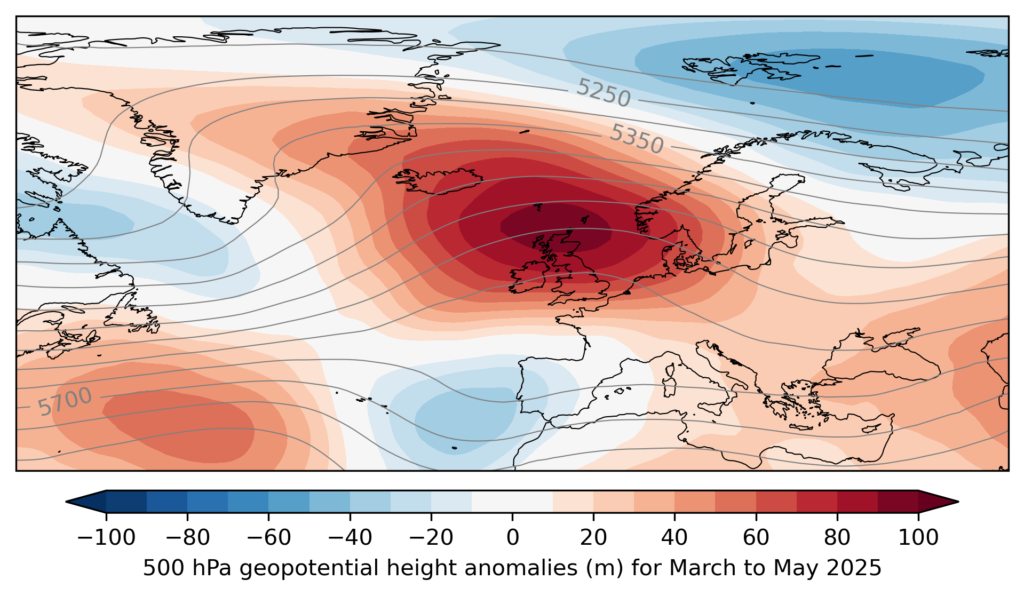IAP-25-032
Linking persistence, predictability and extremes in a changing climate
The impacts of human-caused climate change are already being experienced around the world through the increasing occurrence of extreme weather events, including heatwaves, droughts, and floods. Such extreme weather events are often related to persistent anomalies in the Earth system. For example, extreme heat is often preceded by large soil moisture deficits arising from the prolonged absence of rain-bearing weather patterns.
However, the dynamical processes governing persistence and the links between persistence and extreme events remain relatively poorly understood. This leads to deficits in the representation of persistence in Earth system models, which can limit the ability to predict and prepare for extreme events. Moreover, the rarity of extremes superimposed on the shifting background state of a changing climate means that observations themselves are insufficient: the atmospheric, oceanic and surface conditions required to generate extremes can be rare and may not have even occurred in the current climate. Addressing these knowledge gaps requires a systematic, process-based assessment of large numbers of model simulations.
The goal of this project is to transform our understanding of the drivers and impacts of atmospheric persistence and its representation in models used operationally for subseasonal-to-decadal prediction.
The project will build on recent studies of large-scale circulation regimes, theory and land–atmosphere interactions led by the groups of supervisors Dr Simon Lee (Lee et al. 2023), Dr Michael Byrne (Byrne et al. 2024) and Dr Nick Dunstone (Kay et al. 2025), combining analysis of large ensembles of weather and climate models together with theory and model experiments. The project will address three key objectives:
1. Develop and apply diagnostics to understand persistence and extract plausible extreme events from very large model ensembles.
2. Separate the relative roles of large-scale dynamics versus local-scale processes in the most extreme events.
3. Quantify the role of persistence in subseasonal-to-seasonal prediction of extreme events.

Click on an image to expand
Image Captions
Mid-tropospheric circulation anomalies averaged over March to May 2025, which was the UK’s warmest, sunniest and sixth driest spring on record. (Data source: ECMWF ERA5 reanalysis.)
Methodology
To address the project objectives, the initial focus will be on analysing the Met Office operational decadal prediction system (DePreSys3; Dunstone et al. 2016). This is a leading dynamical prediction system which contributes real-time decadal forecasts every year to the World Meteorological Organisation’s Lead Centre for Annual-to-Decadal Climate Prediction (http://www.wmolc-adcp.org). These will be mined to extract large-scale weather patterns, focusing on Europe and North America (e.g., Lee et al. 2023) using both well-established and novel machine learning methods. The large ensembles will enable a much better understanding of extremely rare configurations of the climate system.
A next step will be to decompose the physical processes which set apart the most persistent events, considering the relative roles of large-scale dynamics versus local-scale processes. Broadening the analysis to examine other prediction systems, leveraging a multi-model database of seasonal forecasts (https://doi.org/10.24381/cds.181d637e), will help develop the extent to which models differ in their treatment of persistence, including the role of biases. For example, differences in the position and/or strength of the jet streams could be explored. It is anticipated that the project student will then design new model experiments involving the Met Office DePreSys prediction system or the ECMWF OpenIFS model, such as perturbing or nudging components of the Earth system, to test hypotheses.
Not only will these innovative simulations advance fundamental understanding of persistence, they will also develop valuable skills for the PhD student in coding, scientific modelling and high-performance computing.
Project Timeline
Year 1
The first year will involve a literature review to allow the student to develop their understanding of atmospheric dynamics and physical climate science. The student will also begin working with the Met Office DePreSys decadal climate prediction data, including a short early visit to the Met Office to gain understanding of operational seasonal-to-decadal prediction and activities of the WMO Lead Centre. The student will also attend the annual UK National Climate Dynamics workshop to broaden their understanding of current research in the area and network with other researchers
Year 2
The second year will focus on developing statistical frameworks to quantify persistence within observational and forecast data, developing hypotheses that might be tested in bespoke modelling experiments that the student will design during an extended visit to the Met Office. The student will present their findings at a national conference, such as the Royal Meteorological Society’s Annual Weather and Climate conference.
Year 3
The third year will focus on understanding the relationship between persistence and extreme events and their predictability, considering the roles of local versus large-scale processes. This will involve substantial data analysis, and the student will also draft a research article on this portion of the project. The student will present the key results at an international conference, such as the European Geosciences Union annual meeting in Vienna.
Year 3.5
The final six months will focus on writing the PhD thesis and drafting a research article on the analyses previously conducted.
Training
& Skills
The student will be trained in several aspects of physical climate science including atmospheric dynamics, ensemble prediction, climate modelling and climate change. The student will also be trained in highly sought-after technical skills in computational modelling, high-performance computing, and quantitative ‘Big Data’ analysis.
References & further reading
Byrne et al. 2024: Theory and the future of land-climate science. Nature Geoscience, vol. 17, 1079–1086, https://doi.org/10.1038/s41561-024-01553-8
Dunstone et al. 2016: Skilful predictions of the winter North Atlantic Oscillation one year ahead. Nature Geoscience, vol. 9, 809–814, https://doi.org/10.1038/ngeo2824
Kay et al. 2025: Rapidly increasing chance of record UK summer temperatures. Weather, vol80, 268–276, https://doi.org/10.1002/wea.7741
Lee et al. 2023: A New Year-Round Weather Regime Classification for North America. Journal of Climate, vol. 36, 7091–7108, https://doi.org/10.1175/JCLI-D-23-0214.1

